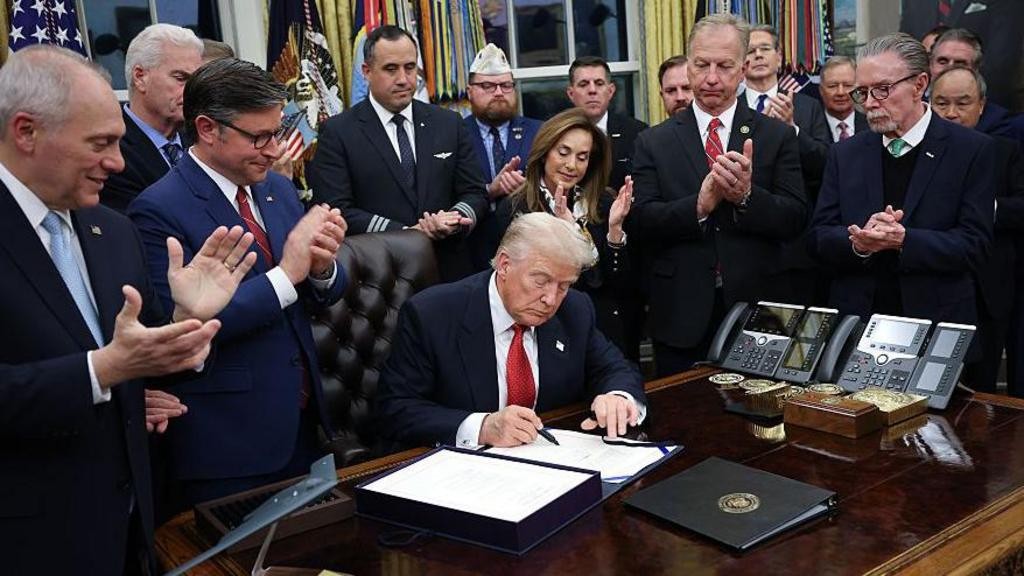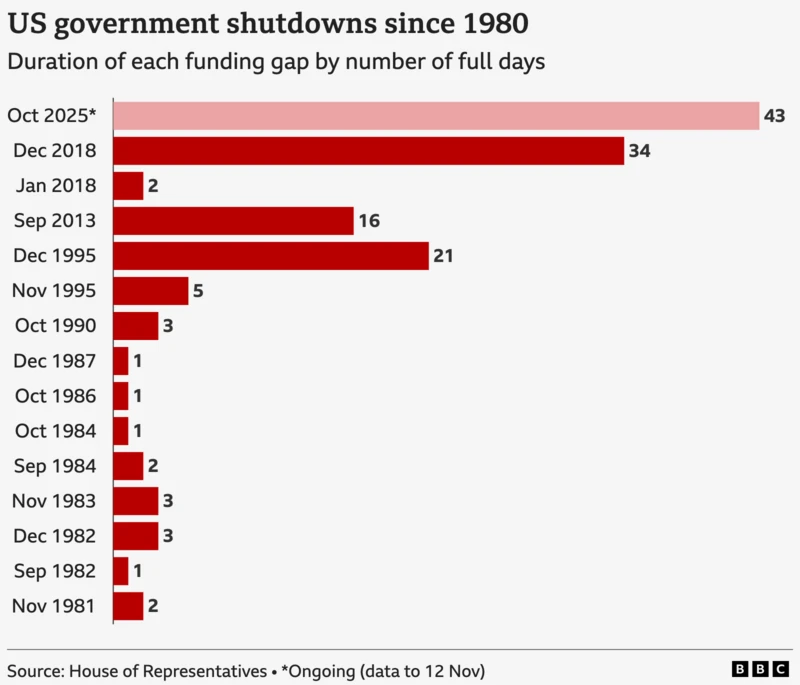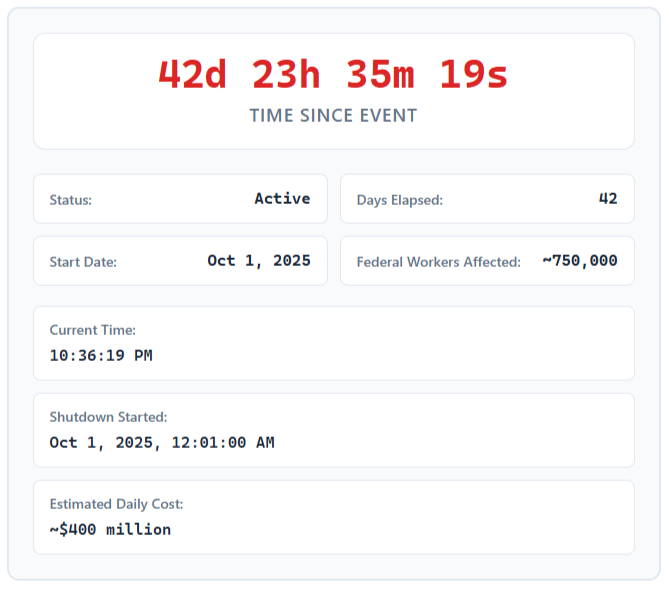市场资讯及洞察

The longest government shutdown in US history has finally ended after 42 long days.
After a month and a half of political theatre, seven Democrats and one independent broke ranks and voted with Republicans to pass a stopgap measure. The Senate went 60-40, the House followed 222-209, and Trump signed it hours later.
The legislation includes three-year appropriations for the Agriculture Department, FDA, military construction, veterans affairs, and congressional operations, along with restoration of pay for federal workers and reversal of Trump administration layoffs through January.
However, the most contentious issue, healthcare subsidies, has been kicked down the road to a December Senate vote.

COVID-era ACA subsidies expire at year-end. When they do, premiums for the average subsidised household will more than double from $888 to $1,904 per year, with an estimated 3.8 million people losing coverage entirely.
If the December vote fails, which is likely considering how far apart the two parties are on the topic, we could see a new shutdown begin in January.

What Happens Next?
This Week:
- Federal employees return to work.
- Paychecks start flowing again.
- SNAP benefits get restored for 42 million people, though heating assistance won't come back for weeks.
- National parks reopen.
- Airports start to go back to normal.
December:
- Senate votes on healthcare subsidies. It will probably fail.
- Premium notices continue to be sent showing 2026 costs doubling.
January 30:
- Government funding expires.
- We do this whole thing over, except now the healthcare subsidies have already expired.
- If Republicans and Democrats remain divided on budget priorities, another shutdown will likely begin.
By the Numbers:
Over the past 42 days, approximately 750,000 federal workers have been furloughed. Another two million worked without pay. Over 42 million had their food assistance delayed. And the FAA cut flights by 10% because air traffic controllers stopped showing up to work.

Further concern is the "data blackout" that has hampered Federal Reserve decision-making. Key economic indicators, including jobs reports, were suspended, leaving the Fed blind during an active rate-cutting cycle.
Meanwhile, separate analyses from Challenger, Gray & Christmas showed layoffs surged 183% in October, which would make it the worst October for jobs since 2003.
The Bottom Line
Today’s deal ended the shutdown, but it didn’t actually solve anything. The deal essentially kicks the can down the road to January while leaving the healthcare crisis unresolved.
With both parties divided on healthcare and spending priorities, and Trump lacking a comprehensive plan to address rising premiums and high deductibles, a resolution in the December vote seems unlikely.
If no compromise is accepted by the time Government funding expires on January 30, another shutdown is almost inevitable.
Impact of Australian Jobs Reports and U.S. Shutdown End on the Aussie


An oil price war and the pandemic struck the crude oil market at a time where the industry was already faced with a simultaneous demand and supply shock. Put simply, crude oil prices were already under pressure due to a flood of supply at a moment of diminishing demand. A Supply Glut which is mainly driven by US shale producers and a Weak Oil Demand Growth driven by the structural shift in the market! 2020 was set to be the confirmation of a new era for climate change.
As we entered a new decade, the extreme weather conditions around the world have forced leaders of many countries to reassess their actions over climate change and transform the global energy system. In the face of stronger climate action, the energy landscape is changing with the rise of renewables and the increased engagement on climate change, but there are still much debates about the pace of the transition and the extent of disruption. The Pandemic As the world grapples with the ongoing pandemic, different forms of lockdowns across the globe have severely impacted key industries of consumers of oil.
Global activities have slowed down on a massive scale with empty roads, grounded aircraft, plunging car sales and disrupted supply chains abruptly sapping oil demand. The extent of the disruptions in the energy market caused by the pandemic might leave a lasting impact on the oil market which may take years to overcome. Overall, it might still be too early to see that the pandemic could be the reason that either accelerate the pace in using renewables or delay that process.
Below $50 The coronavirus outbreak has caused crude oil prices to fall to its lowest level in more than a year and tumbled below a key $50 level. In a desperate attempt to stabilise oil prices, the world’s biggest oil producers have agreed to slash the world’s oil production to lower supply to counter the steep fall in demand. Source: Bloomberg Terminal Oil Demand Outlook While weekly crude oil inventory reports might provide some relief from time to time to the oil market, traders are mostly concerned with the ongoing uncertainty on the demand outlook.
The Oil Market Report October 2020 and the World Energy Outlook 2020 released this week provided some clarity on the energy market. In its October report, the International Energy Administration (IEA) reported that volumes of crude oil held in floating storage fell sharply by 70 mb (2.33 mb/d) to 139.1 mb in September. The IEA also predicted a significant stock draw in the fourth quarter which provided some support to crude oil prices.
However, the World Energy Outlook 2020 report released earlier this week reiterates the struggles of the energy market in the coming years. The organisation identified four main scenarios to analyse key uncertainties ranging from an energy world in lockdown to mapping out and building a sustainable recovery: The Stated Policies Scenario (STEPS) The COVID-19 pandemic has caused more disruption to the energy sector than any other event in recent history, leaving impacts that will be felt for years to come. In this scenario, COVID-19 is brought under control in 2021 and the global economy returns to pre-crises levels the same year.
The Delayed Recovery Scenario (DRS) In this scenario, the shadow of the pandemic looms large - Global energy demand rebounds to its pre-crisis level in early 2023 in the STEPS, but this is delayed until 2025 in the event of a prolonged pandemic and deeper slump, as in the DRS. In the Sustainable Development Scenario (SDS), a surge in clean energy policies and investment puts the energy system on track to achieve sustainable energy objectives in full, including the Paris Agreement, energy access and air quality goals. The new Net Zero Emissions by 2050 case (NZE2050) extends the SDS analysis.
A rising number of countries and companies are targeting net-zero emissions, typically by mid-century. Given the forecasts on the demand side, there is also increasing pressure from OPEC members and its allies to balance the supply side and avoiding flooding the oil market with extra supply. Crude oil prices have remained stuck within a range below the $50 mark as oil traders struggled to push prices higher dragged by the dire demand outlook.
The energy sector is among the worst-performing sector in the stock market as investors are also shifting their investment towards green energy. As lockdown eased, traders will likely eye the consumption of oil in emerging and developing countries rather than developed countries which are taking more steps towards climate change. The US election outcome might also be a driver of crude oil prices in the next couple of weeks as it will depend on the stance of the government towards climate change policies.


Critical Hours for Brexit As the clock ticks for Brexit, Brussels and London seem to be working harder than before on their differences for a last-minute Brexit deal. The headlines in the past 48 hours have renewed optimism that the UK and European Union may secure a deal. However, even though the negotiations appear to be moving in the right direction and the related parties are keen to get a deal done, there is still some scepticism on the pace of developments ahead of the EU meeting.
Last- Minute Deal If there are enough concessions to allow for a deal, Prime Minister Boris Johson will have a deal to put through to Parliament in a special sitting on Saturday, the 19 th of October. The circumstances to call for a Saturday meeting are still not clear and are based on how the negotiations unfold. The recent flexibility on both sides is so far paving the way to the UK Prime Minister bringing a deal back from the EU to table in a special meeting on Saturday.
Deal or No Deal The Prime Minister will be forced to ask for a delay - deal or no deal. In the case of a deal this week, it will be a race against time trying to finalise an agreement and arrange for the draft to pass through the votes to exit the European Union on the 31 st of October. But the delay will be mostly to complete the formalities of a deal and will probably not dampen the recent optimism.
In the likelihood, that a deal with the EU is stalled or the deal that the Prime Minister negotiated with the EU is blocked in Parliament, the Prime Minister will be forced to seek for an extension under the Act of Parliament to the Brexit withdrawal data unless he finds a way around the Act. Markets Reactions Brexit hopes have steered risk sentiment in the European markets as the three-year-long Brexit saga seems to be coming to an end. It could be exhaustion that has caused both the EU and UK to be more flexible in allowing Brexit to happen.
European indices rose higher while the FTSE 100 closed slightly in the red due to a resurgent pound. Global equities rallied across the board despite growth forecasts from the IMF. According to the IMF, the global economy is growing at its slowest pace since the financial crisis and would hit only 3% this year.
The UK is expected to grow at 1.2% in 2019 compared to 1.4% last year due to Brexit-related uncertainties. Source: Bloomberg Terminal The British Pound As the UK appears to be on the point of a breakthrough on a Brexit deal, the Pound is soaring and the Sterling has room for more upside movement if Brexit hurdles are cleared. However, in anticipation of more clarity this Wednesday, the GBPUSD pair is in the consolidation phase just below the 1.28 level.
GBPUSD (3 Day-Chart) Source: Bloomberg Terminal We expect the Sterling pairs to remain volatile ahead of the summit! All in all, the path of the Pound in either direction would be sharp and volatile. A deal with the EU backed by parliament could send the pair rallying to 1.40 level while a disruptive no-deal outcome could see the pair plummeting to the lowest level seen in 2016.


The Parliament Vote is the pivotal stage for Brexit. If the Brexit deal is accepted, Britain will exit the EU in an orderly way. However, if the proposed Brexit deal is rejected, there will be many uncertainties to follow.
Market participants will have to wait and see how Brexit will unfold as and when more information or decisions will be made public. If the Brexit deal is rejected, market participants will consider the following scenarios: Revised Brexit Deal At this stage, there are growing chances that Parliament may reject the withdrawal agreement. In the case Parliament rejects the deal; May will have to return to the EU and seek more concessions to pursue a second vote.
Bearing in mind that the EU has been clear that the withdrawal deal would not be re-negotiated, material changes to the agreement are therefore unlikely. A narrow defeat will mean that Theresa May may attempt to seek cosmetic changes from the EU that will increase the likelihood of the deal being approved in the second round. However, if a significant margin defeats her, it will hard to convince the EU to make changes that may impact the outcome of the vote.
Early Election There are reports that the Labour Party is planning to trigger an early election “within days” if Theresa May is defeated in Parliament. If an election is not called immediately, it will then be difficult for the Labour Party to have sufficient time for an election and negotiate a better deal with the EU. Would the PM use her power to set the date of the election in April- after the Brexit vote?
This possibility has been crossing wires, as of writing. No-Deal Brexit If the vote is rejected across the House of Commons and no consensus can be found, Brexit will happen without a deal. No-Deal Brexit will mean that Britain will leave the European Union with no formal agreement on the terms of UK’s withdrawal or new trade relations.
Second Referendum As the risks of a no-deal Brexit rise, the probability of a second referendum appears to increase as well. The campaign for the second referendum is crucial in determining a solid and informed outcome which means that the referendum will take time and Brexit will likely be postponed. There are higher chances that the EU will agree to delay or extend Article 50 on the basis on a second referendum rather than for more concessions on a new Brexit deal.
Britain has to obtain a unanimous vote from the EU members to extend the deadline. No Brexit As of writing, “No-Brexit” is making more headlines than “No-deal Brexit”. The Prime Minister strongly believes that No Brexit will let down the people who voted for Brexit and will be a catastrophe for the British democracy.
The stakes of what happens today are high. Traders who are trying to make sense of it all are finding it hard to know how Parliament will proceed should the vote be rejected. Brexit is a headache that has kept its local currency and the FTSE trapped.
The Brexit Impact on the Pound Traders are widely expecting the agreement to be rejected. After last Friday’s surge to the upside, the GBPUSD pair has gone into consolidation phrase ahead of the important vote. A second referendum can be favourable for the Pound and may trade to the levels seen before the initial vote in 2016.
On the other side, a No-Deal Brexit may push the Sterling pairs further to the downside. The news of a general election can stabilise the Pound or help the local currency to advance modestly higher until the outcome of the election is known. GBPUSD Source: GO MT4


As we head into the Thanksgiving holidays, the continuing factors dominating headlines remain Brexit and Italy. This Wednesday was an important day for Brexit and Italy, but the events unfolded without any major catalysts or breakthrough. Theresa May and Jean-Claude Juncker meeting in Brussels: It appears that some progress has been made.
The comments unfolding after the meeting were positive “ further progress has been made, very good progress”. However, it looks like both parties still failed to reach a final deal as Theresa May will be flying back to Brussels on Saturday ahead of Sunday EU summit to conclude the progress made. Brexit continues to be the primary driver for the Sterling pairs.
After last week’s sharp decline, the GBPUSD pair has been navigating within the 1.27 and 1.28 range finding buyers only at times when the US dollar is weaker. At first glance, on the hourly chart, we can see that the 1.288 mark which acted as a support line before the deep fall is now acting as a resistance line. There were a few attempts to break through and move towards the 1.29 level, but bulls were unable to push beyond that resistance line.
The renewed weakness in the US dollar failed to lift the pair as sentiment remained dampened by Brexit uncertainties. The last-minute talks and the race against time are making investors nervous and reluctant to take the local currency in a firm direction unless there is more clarity on the remaining issues. GBPUSD (Hourly Chart) Would the exit agreement be signed on Sunday or be postponed?
The European Union (EU) decision on Italy: The EU once again rejected Italy revised draft and is moving closer to placing sanctions on Italy for not submitting a budget proposal that abides by the rules. The Budget included the fulfilment of election promises explaining why Italy is keen to push such a big spending budget. Domestic politics mostly drive the shared currency.
At the moment, the EURUSD is finding upside support when the greenback is falling. On Tuesday, the pair broke from the bearish trend, it was trapped in since the end of September, but Brexit and Italian budget jitters are keeping a lid on the gains. So far, the pair is struggling to retest this month high and is currently trading in the 1.13 range.
The current situation is paving the way for an Excessive Deficit Procedure (EDP) against Italy and traders will likely monitor any developments on that matter!


Commodities markets were on sell-off mode on Friday. The black and yellow gold was sent to the downside dragged by the disappointing Purchasing Managers Index data. Gold - XAUUSD The Chart shows that Gold price pulled back as from last Wednesday on a broad-based US dollar strength and retreated from its 2019 highs.
The yellow metal struggled to find buyers amid a risk-on mode. Being driven mostly by the greenback, Gold traders will eye the series of US data releases this week for fresh trading impetus. Central banks rate decisions scheduled across the week and trade or Brexit headlines may also bring some volatility.
Technically, XAUUSD is in the RSI oversold conditions and the positive trade headlines emerging this morning might help the yellow metal to bounce back. After being in a consolidation period throughout the month of January, XAUUSD has continued trading to the upside capped by a rising trend line. However, gold prices gave up the bullish momentum and dropped below the line setting a bearish tone for XAUUSD.
XAUUSD (Daily Chart) Source: GO MT4 WTI and Brent Crude Oil prices were also under pressure on Friday whereby WTI and Brent Crude erased more than 2%. After ending February in positive territory, oil prices started a new month in the red. The tightening of global supplies and the US sanctions have supported the upside price action of oil prices since the beginning of the year and last week sell-off started with President Trump’s comments on high oil prices.
UKOUSD and USOUSD (H4 Chart) Source: GO MT4 We expect the weekly oil reports to provide short-term direction for oil prices: Tuesday: API Weekly Crude Oil Stock Thursday: EIA Report Friday: Baker Hughes US Oil Rig Count This article is written by a GO Markets Analyst and is based on their independent analysis. They remain fully responsible for the views expressed as well as any remaining error or omissions. Trading Forex and Derivatives carries a high level of risk.


Boeing (BA) The Aerospace giant beat estimates and reported a record $101.1bn revenue for the year 2018. It is the first time that the company reports more than $100bn as annual revenue. Below is a summary of the fourth quarter earnings.
Record revenue of $28.3 billion and record operating profit of $4.2 billion driven by higher volume Record GAAP EPS of $5.93 and record core EPS (non-GAAP) of $5.48 on a strong performance Despite some uncertainties around trade tensions that rattled Boeing’s stock in the past few months, the year-end results far-exceeded Wall Street’s expectations. We saw record numbers in commercial aeroplane deliveries, which indicates a strong demand for commercial air travel. The quarterly results helped drive the equity markets: Boeing’s share price jumped to $387.72, up by 6.25%: The Dow Jones Average Industrials surged higher by 1.77% which is an addition of 434.90 points.
The upbeat corporate earnings and a more dovish Fed helped the index close above 25,000, for the first time since December. Boeing and China have a close relationship, and the CEO of the aerospace giant who has been involved in discussions with both governments sees progress on the trade front: “China needs airplanes for growth to fuel their economy, while in the U.S., the aerospace industry is a “tremendous” jobs generator.” The Company provides the following guidance on its outlook for 2019: Revenue guidance of between $109.5 and $111.5 billion reflects higher volume across all businesses GAAP EPS of between $21.90 and $22.10; core EPS (non-GAAP)* of between $19.90 and $20.10 Operating cash flow expected to increase to between $17.0 and $17.5 billion Despite the current trade tensions, it is good to see a company which is closely linked with China beating estimates and raise EPS and revenue forecasts. Facebook Another surprise on the upside was Facebook.
Despite privacy-related scandals, Facebook beats quarterly revenue and profit estimates. The growth was supported by Instagram business and the rise in advertising spending by companies. Fourth Quarter and Full Year 2018 Operational and Other Financial Highlights: Daily active users (DAUs) – DAUs were 1.52 billion on average for December 2018, an increase of 9% year-over-year.
Monthly active users (MAUs) – MAUs were 2.32 billion as of December 31, 2018, an increase of 9% year-over-year. Mobile advertising revenue – Mobile advertising revenue represented approximately 93% of advertising revenue for the fourth quarter of 2018, up from approximately 89% of advertising revenue in the fourth quarter of 2017. Capital expenditures – Capital expenditures were $4.37 billion and $13.92 billion for the fourth quarter and full year 2018, respectively.
Cash and cash equivalents and marketable securities – Cash and cash equivalents and marketable securities were $41.11 billion at the end of the fourth quarter of 2018. Headcount – Headcount was 35,587 as of December 31, 2018, an increase of 42% year-over-year The company’s privacy and data practices came under heavy scrutiny last year, yet this did not deter companies to ramp up advertising ads with Facebook. The release of the earnings report was overshadowed by the news that Facebook paid teens in order to monitor their phones via an unsettling research app which is only allowed to be used by Facebook or its employees.
Facebook’s share price was rallying ahead of its earnings and gained 17.32% so far post-report in the extended hours. Despite companies like Caterpillar, Tesla and Microsoft missing estimates or downgrading forecasts, Apple, Boeing and Facebook are among those that surprised on the upside. More dovishness from the Fed is also providing support to the equity markets.

